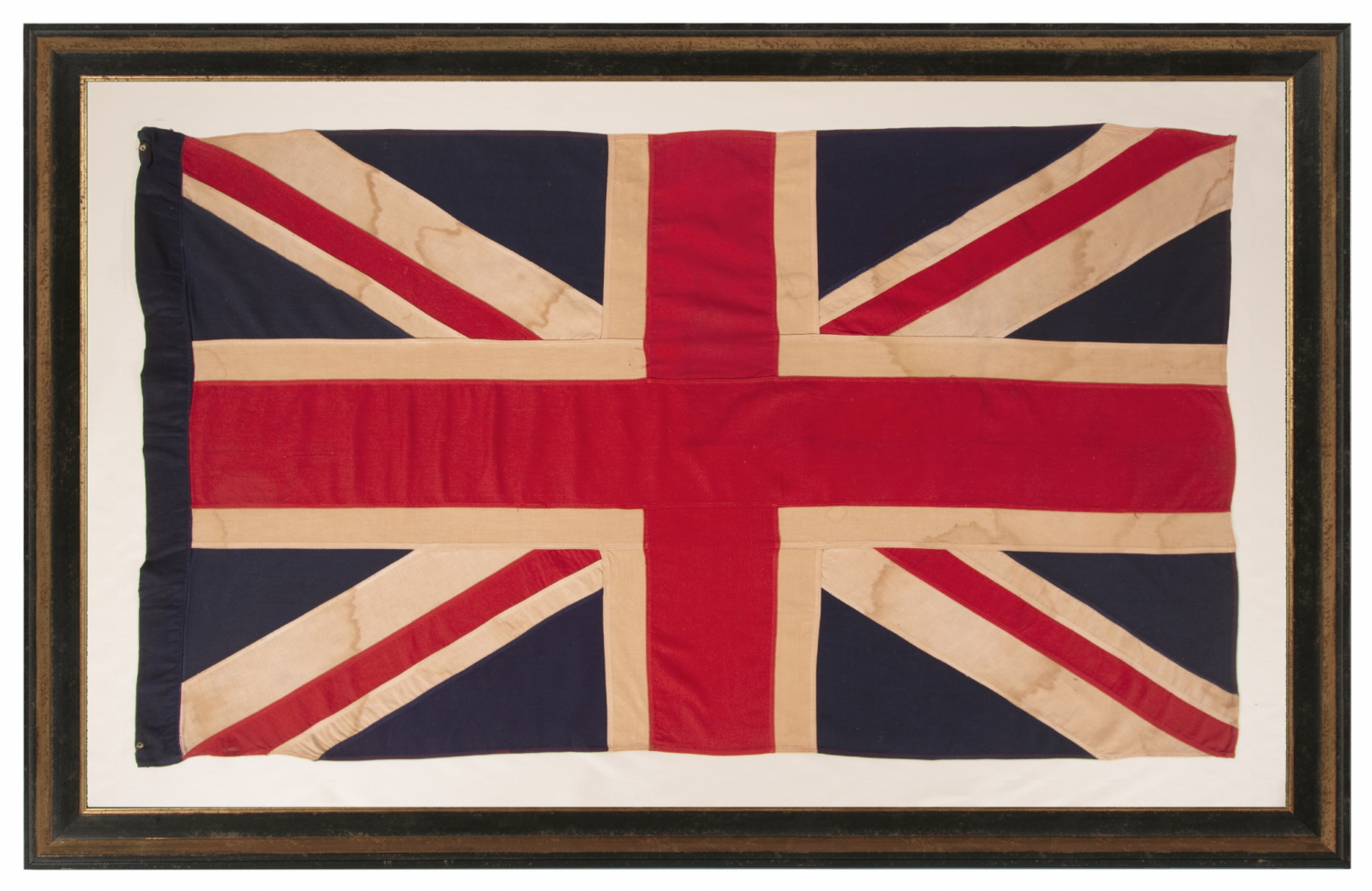
| |
BRITISH UNION FLAG ("UNION JACK") OF THE 19-TEENS – THE 1930’s, MADE OF COTTON BUNTING, VERY UNUSUAL WITH A BLUE HOIST BINDING |
|
| Available: |
Sold |
| Frame Size (H x L): |
Approx. 47" x 74" |
| Flag Size (H x L): |
34.75" x 62.25" |
|
| Description....: |
|
British Union Flag, better known as the "Union Jack," made sometime between WWI (British involvement 1914-1918) and the 1930’s. The crosses of St. George, St. Patrick, and St. Andrew, and the blue ground, are all made of cotton bunting. Measuring approximately three by five feet, all of the piecework was accomplished with machine stitching. Note how the blue fabric along the hoist was rolled over, lined with plain weave, white cotton, and hemmed, to form a wide, open sleeve. Leather tabs were stitched in placed at the top and bottom of the hoist, split in such a way that the end of a staff or a rope could be affixed. This manner of attachment is typically reserved for flags that were intended to be carried on foot. At some point, holes were pierced through from the leather, through the cotton lining and sleeve, perhaps so these could serve as grommets.
Cotton Union jacks of this era, with pieced-and-sewn construction such as this, are few and far between. The blue coloration of the hoist is both unusual and makes for a very interesting visual feature.
Basic Facts Surrounding Use of The British Union Flag / Union Jack:
The term “Union Jack” comes from the fact that the device, by itself, was not flown on British ships as its primary colors. The crosses of St. George (to reflect England), St. Andrew (to represent Scotland), and St. Peter (as of January 1st, 1801, to include Ireland), that create what is known as the British “Union Flag,” was instead flown by the Royal Navy as a jack. A jack was flown off the bow when a ship was at port or anchor. In both Britain and the United States, this is officially called the “Union Jack”—a fact that makes the name pretty confusing. In each case it consists of the canton (union) of the national flag flown on the respective ship.
In America, the “Union Jack” is a blue field with white stars. Its size is to be that of the canton of the Stars & Stripes flown by the same ship as its national ensign.
In Britain, there were several variations of the national flag, instead of just one, called the red, blue, and white ensigns. Each consisted of either a red, white, or blue field, with the British “Union Flag” serving as its canton. So the “Union Jack” was the Union Flag by itself. The term “Union Jack” stuck as the common name for the device, no matter how it was employed.
No law has ever been passed to make the Union flag / “Union Jack” the national flag of the United Kingdom. Instead it has become so through precedent. Its first recorded recognition as a national flag came in 1908, when it was stated in Parliament that "the Union Jack should be regarded as the National flag". A more categorical statement was made by the Home Secretary, Sir John Gilmour, in 1933 when he stated that "the Union Jack is the National Flag". It is still officially a flag of the monarch, however, rather than of the nation.
Civilian use of the Union flag is permitted on land, but non-naval/military use at sea is prohibited. On land, the Union Jack can be flown by any individual or organization on any day they wish. Until very recently, however, government use was strictly regulated. Prior to 2007, it could only be flown on government buildings on certain specified days, such as those marking the birthdays of members of the Royal Family, the wedding anniversary of the Monarch, Commonwealth Day, Accession Day, Coronation Day, The Queen's official birthday, Remembrance Sunday and on the days of the State Opening and prorogation of Parliament.
At sea, different rules apply. Prior to 1864, the Red Ensign, White Ensign, and Blue Ensign were all flown by ships of the Royal Navy (RN). In that year, all RN ships were ordered to fly the White Ensign and it became the sole naval flag of the United Kingdom. Until the mid- to late 1960's, the White Ensign was also flown by Canadian, Australian and New Zealand warships. The Blue Ensign was reserved for merchant vessels whose masters are qualified Royal Naval Reserve [RNR] officers and which meet certain other requirements, while the Red Ensign became the British civil ensign.
At sea, the Union Jack is reserved for the RN and no other British ships are permitted to fly it.
Mounting: The flag was mounted and framed within our own conservation department, which is led by expert staff. We take great care in the mounting and presentation of flags and have preserved thousands of examples.
The mount was placed in a black-painted Italian molding with a sculpted profile and a silver gilded inner edge. The background is 100% hemp fabric or a hemp & cotton blend (we use both interchangeably). The glazing is U.V. protective Plexiglas. Feel free to contact us for more details.
Condition: There is minor to modest oxidation throughout, accompanied by moderate water staining, most apparent on the white bunting. The flag presents beautifully. Many of my clients prefer early flags to show their age and history of use. |
|
|
|
| Collector Level: |
Intermediate-Level Collectors and Special Gifts |
|
| Flag Type: |
Sewn flag |
|
| Star Count: |
|
|
| Earliest Date of Origin: |
1914 |
|
| Latest Date of Origin: |
1939 |
|
| State/Affiliation: |
|
|
| War Association: |
WW 1 |
|
| Price: |
SOLD |
|
| |
Views: 1240 |
|
|
|

